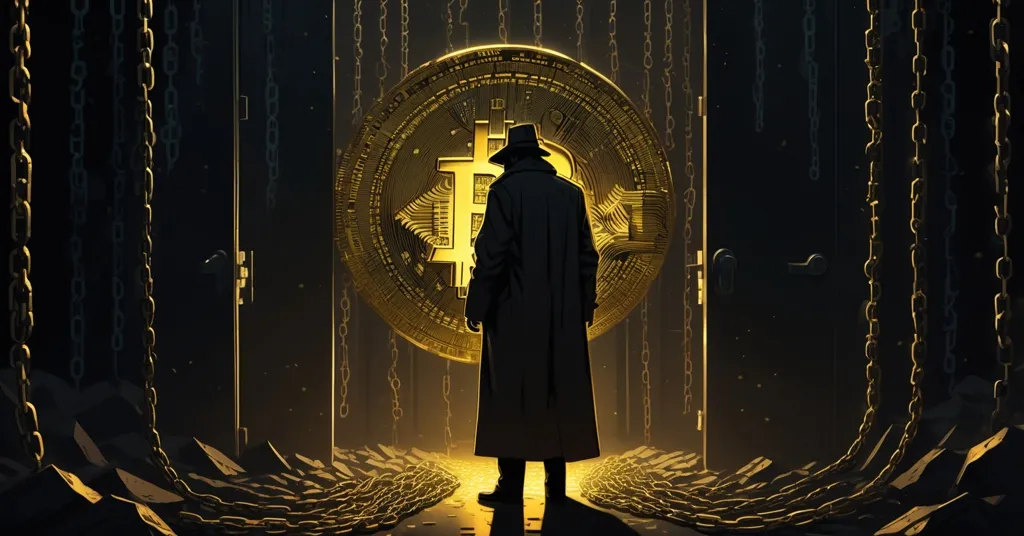Galaxy Digital’s $9B Bitcoin Sale: 80K BTC Tied to MyBitcoin Hack Sparks Controversy

80K Bitcoin Whale Exposed? Galaxy Digital’s $9 Billion Deal Tied to MyBitcoin’s Dark Past
A bombshell has rocked the Bitcoin world: Galaxy Digital, a heavyweight in the digital asset space, has facilitated the sale of over 80,000 BTC, valued at a staggering $9 billion. This transaction, one of the largest in Bitcoin’s history, has unleashed market turbulence, fueled wild speculation about the seller’s identity, and dragged up ghosts from the early days of crypto with links to a notorious 2011 hack.
- Historic Sale: Galaxy Digital executes a $9 billion deal involving 80,000 BTC, shaking the market.
- Ancient Coins: The Bitcoin, dormant for 14 years, traces back to MyBitcoin, a wallet service hacked in 2011.
- Unknown Seller: Theories point to the hacker or MyBitcoin’s founder, Tom Williams, as the potential owner.
- Ethical Concerns: Questions loom over the legitimacy of the coins and Galaxy Digital’s due diligence.
The Colossal Transaction: $9 Billion in Bitcoin Changes Hands
Let’s set the stage with the raw scale of this event. Galaxy Digital, a financial services giant bridging traditional finance and crypto, orchestrated the sale of 80,000 BTC—a stash worth over $9 billion at current prices. This isn’t just a big deal; it’s a historic milestone, ranking among the largest Bitcoin transactions ever recorded. For perspective, that’s enough Bitcoin to make even the most seasoned crypto whale look like a minnow. The sheer volume sent shockwaves through the market, but what’s got everyone buzzing isn’t just the numbers—it’s the shadowy origins of these coins and what this deal means for Bitcoin’s maturing ecosystem.
Galaxy Digital has remained cagey about the specifics, only stating the transaction was part of a client’s “real estate planning strategy.” That’s a polite way of saying someone’s cashing out big time, possibly diversifying into tangible assets or setting up generational wealth. But with a $9 billion paycheck, you’d expect a bit more transparency, especially when the coins in question have a history murkier than a swamp at midnight. This lack of clarity only fuels the fire of curiosity and concern within the crypto community.
A Ghost from Bitcoin’s Past: The MyBitcoin Connection
The plot thickens when we dig into where these Bitcoins came from. According to Ki Young Ju, CEO of blockchain analytics firm CryptoQuant, the coins had been sitting idle for 14 years, tied to wallets associated with MyBitcoin, a now-defunct wallet service. For those new to the crypto saga, MyBitcoin was a name from Bitcoin’s Wild West era—a time around 2010-2011 when security was a joke and hacks were as routine as sunrise. MyBitcoin collapsed in 2011 after a massive breach, with reports suggesting thousands of users lost their funds, some estimates pointing to hundreds of BTC stolen, though exact figures remain murky due to poor record-keeping back then. The service vanished overnight, leaving behind a trail of burned investors and unanswered questions, as detailed in accounts of major crypto hacks from that era.
This wasn’t just a blip; it was a scar on Bitcoin’s early adoption. Events like the MyBitcoin hack—alongside infamous disasters like Mt. Gox—highlighted the fragility of the nascent crypto space, where trusting third parties with your keys often meant kissing your money goodbye. Fast forward to today, and the resurfacing of these coins brings back those bitter memories. Are we dealing with the spoils of that 2011 heist, or did an early adopter just wake up from a 14-year nap with a fortune to liquidate? Theories swirl around two prime suspects: the hacker who pulled off the original theft or Tom Williams, MyBitcoin’s elusive founder, who’s been harder to pin down than Satoshi Nakamoto on a bad day, with ongoing speculation about his identity.
Market Fallout: Volatility, Resilience, and Ethereum’s Edge
The immediate aftermath of this whale-sized sale was predictable: chaos. Bitcoin’s price took a dive, slipping below the 100 Simple Moving Average (SMA) at $117,471—a key trend indicator, like checking the average vibe of the market over a set period to gauge if it’s trending up or down. It found a foothold at $115,724 before rebounding to hover around $117,300. Now, it’s staring down resistance at $118,118 (the 50 SMA) and a range high of $122,077. For the uninitiated, resistance levels are price points where selling pressure often kicks in, stalling upward climbs, while support levels are where buying tends to step in to prevent further drops. If Bitcoin punches through $118,118, we might see bullish momentum; if it cracks below $115,724, brace for deeper pain.
Despite the turbulence, there’s a twist—data from Lookonchain shows nearly 30,000 BTC of the total were sent to exchanges in calculated chunks throughout the day. This wasn’t a blind dump; it was a surgical strike to lessen the blow on the market. Still, the volatility rattled nerves. Meanwhile, Ethereum, Bitcoin’s long-standing rival, held its ground with surprising strength. Why? Likely because its ecosystem—packed with decentralized finance (DeFi) protocols and staking yields—offers a buffer against Bitcoin-specific drama. It’s a reminder that crypto isn’t a single-track race; different assets play different games, and Ethereum’s carving out a niche as a go-to for diversified investors during Bitcoin’s rocky moments, as some discussions on Bitcoin market reactions also highlight.
Yet, let’s not overplay the doom and gloom. Bitcoin’s been riding high recently, smashing past $123,000 with tailwinds from ETF inflows and corporate adoption. Analysts like Jason Williams and Joe Consorti from Theya are waving the resilience flag hard. Consorti noted Bitcoin “barely moved” despite the $9 billion sell pressure, while Williams is already calling for higher prices. This isn’t 2011—today’s market has deeper liquidity, thanks to institutional buyers and Bitcoin ETFs soaking up billions in capital. For instance, spot Bitcoin ETFs in the U.S. have seen net inflows exceeding $20 billion since their launch, per recent data. That’s a shock absorber we didn’t have a decade ago. But not everyone’s buying the hype—some bears argue a sale this massive signals wavering confidence among early holders. Could this be the first tremor of bigger dumps to come, as reported in coverage of this massive BTC sale?
Ethical Minefield: Tainted Coins and Transparency Woes
Now, let’s address the elephant in the room: the legitimacy of these coins. If they’re indeed linked to the 2011 MyBitcoin hack, we’ve got a problem. Blockchain forensics—tools used to trace the history of transactions on a public ledger—can often flag “tainted” coins tied to illicit activities like hacks or money laundering. Firms like CryptoQuant and Chainalysis specialize in this, tracking the flow of funds across wallets to identify suspicious patterns, as noted by Ki Young Ju’s analysis on dormant wallets. But here’s the rub: even with transparency baked into blockchain, accountability isn’t guaranteed. Did Galaxy Digital run these checks? Their silence on the matter is deafening, and frankly, it’s infuriating. When you’re handling $9 billion in potentially dirty Bitcoin, “no comment” doesn’t cut it.
This isn’t just about one transaction; it’s about the crypto industry’s credibility. If tainted assets can slip into mainstream markets through institutional players like Galaxy Digital, what’s stopping a flood of illicit wealth from being laundered under the guise of legitimacy? The stakes are higher now that crypto is cozying up to traditional finance. Galaxy Digital isn’t some shady exchange in a basement—they’re a bridge to Wall Street. Their role in this deal could either build trust or torch it, depending on how they handle the fallout. If we’re serious about mass adoption, glossing over ethical potholes like this is a non-starter, especially when considering the broader impact of tainted coins on crypto’s value.
Bitcoin Maximalist Lens: King BTC Still Reigns
As Bitcoin maximalists, we can’t help but see this as further proof of BTC’s unshakeable dominance. A $9 billion sell-off that barely dents the price? That’s the kind of staying power altcoins can only dream of. Bitcoin’s network effects, liquidity, and status as digital gold remain unmatched, even when ghosts from its past come knocking. Sure, Ethereum’s holding steady with its DeFi wizardry and staking perks, and we respect the niche it fills—Bitcoin doesn’t need to be everything to everyone. But when push comes to shove, Bitcoin absorbs blows like a champ, proving it’s the backbone of this revolution. Altcoins innovate, but Bitcoin endures.
Real Estate Planning or Strategic Exit? The Bigger Picture
Let’s chew on Galaxy Digital’s cryptic “real estate planning strategy” comment. On the surface, it suggests an early Bitcoin investor—possibly one of the first millionaires or billionaires from the 2010s—cashing out to diversify into physical assets or set up inheritance plans. Turning digital gold into generational wealth isn’t as simple as hitting “send” on a wallet. There are legal minefields (think capital gains taxes in the millions) and logistical nightmares (how do you prove ownership of coins from 14 years ago without a paper trail?). If these coins are tainted, the mess gets uglier—imagine trying to explain that to the IRS or estate lawyers.
This could be the tip of the iceberg. Are we witnessing the first wave of Bitcoin whales offloading their stacks for legacy planning? If so, expect more mega-transactions as early adopters grapple with wealth transfer in a regulatory gray zone. From an effective accelerationism standpoint, that’s not entirely bad—events like this force the industry to mature fast. They push regulators, firms, and developers to tackle transparency, accountability, and legal frameworks head-on, even if it’s a painful grind. Disruption isn’t pretty, but it’s necessary, as speculation continues around whether this whale’s identity ties back to MyBitcoin.
Key Takeaways and Burning Questions
- What’s the big deal about Galaxy Digital’s 80,000 BTC sale?
This $9 billion transaction is one of Bitcoin’s largest ever, causing market volatility and spotlighting institutional involvement in crypto, showing how far Bitcoin has come as an asset class. - Who might be behind these dormant Bitcoins?
Speculation points to the 2011 MyBitcoin hacker or founder Tom Williams, though Galaxy Digital’s “real estate planning” hint suggests a legitimate early investor could be liquidating. - Why are the origins of these coins a concern?
Tied to a 2011 hack, these coins raise red flags about their legitimacy. Without clear due diligence from Galaxy Digital, there’s a risk of tainted assets seeping into mainstream markets. - How is Bitcoin’s price holding up post-sale?
After dipping to $115,724, Bitcoin stabilized near $117,300. Analysts argue the market absorbed the hit, thanks to deep liquidity from ETFs and institutional demand, though bears warn of future dumps. - What’s behind Ethereum’s resilience compared to Bitcoin?
Ethereum’s strength likely comes from its DeFi ecosystem and staking yields, offering investors alternatives during Bitcoin’s turbulence, reflecting the diverse dynamics of crypto markets. - Could this signal broader trends for Bitcoin whales?
Possibly—early investors may be cashing out for inheritance or diversification, hinting at future large sales and the need for clearer legal frameworks in crypto wealth transfers.
Final Thoughts: Promise and Peril on Bitcoin’s Road
This $9 billion saga is more than a headline—it’s a mirror reflecting Bitcoin’s journey from a scrappy experiment to a financial juggernaut. The ghosts of 2011 hacks like MyBitcoin remind us of crypto’s messy roots, where trust was a gamble and losses were brutal. Yet, the market’s ability to shrug off a punch this big shows how much has changed—Bitcoin isn’t the fragile toy it once was. Ethereum’s steady performance adds another layer, proving the space isn’t a one-horse race but a sprawling battlefield of ideas and innovations.
As champions of decentralization, privacy, and shaking up the status quo, we cheer Bitcoin’s potential to rewrite the rules of money. But we can’t ignore the dark side—ethical lapses and unanswered questions about tainted coins threaten the very freedom we fight for. If crypto is to win hearts and wallets worldwide, it must face these shadows head-on. So, as we marvel at Bitcoin’s resilience, let’s ask ourselves: can its promise of liberty ever fully outrun the skeletons of its past?



